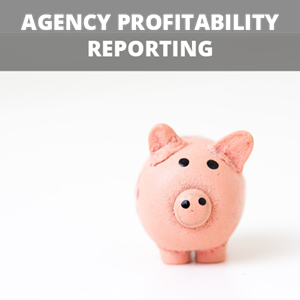Agency KPIs: Project profit margins
| In: Agency management | Financial reporting

Effective reporting is the cornerstone of a successful agency, taking it from a functioning business to a thriving and flourishing one.
Here, we’ll look at one of the top five metrics you should track to power your profits and grow your agency: Project profit margins.
Why is it important?
It can be easy to fall into the trap of thinking big projects are the most profitable. But how much of that revenue translates into profit?
If projects are underquoted or regularly running over, you’re losing profit. Here’s a sobering thought. If you overrun by just 10%, you’re effectively working for free for five weeks of the year.
What does it tell you?
If a job or retainer is making your agency money or not.
This can be tricky to pin down, but taking a deep dive into the profitability of each project can show you which projects or phases make the most profit and what’s least profitable so you can focus on work that makes you money.
Key questions to ask yourself:
- What jobs generate the most profit? How can we do more of that work?
- Which jobs generate the least profit? Can we stop doing them? Or can we deliver them more profitably?
- Which phases or stages generate the most profit on a job? Why? Is it the type of work? The people working on it? The client? The project manager?
Who’s responsible?
Commercial leaders should make sure every project is analysed. And everyone should be involved in the debrief to determine what they could do better next time.
Some agencies reward their teams for achieving target project profit margins. Whilst this can be effective, make sure you’re also measuring client satisfaction to avoid sacrificing service in your quest for profit.
How can you measure it?
Project profit = Revenue - Cost to deliver (time, purchases and expenses)
Project profit margin = Project profit / Revenue
You can use spreadsheets to analyse the data, or Synergist can do it automatically for you. You can add employees’ cost rates to each staff record (‘resource level costing’) or use a blended cost rate by role (‘charge code’), such as designer, art director or account manager.
Synergist calculates profit on a job at three stages:
- When you estimate a new job or job phase, Synergist uses a resource cost per hour x number of hours calculation to represent the potential profit for each estimate line. It can also show you the estimated and actual totals for time, materials and purchases, giving you an overview of net and gross estimated profit.
- When you’re running a job, Synergist allows you to track the actual time and the costs incurred to give you a real-time view of estimated vs. actuals, quoted and invoiced values. You can see all jobs at a glance on your ‘Job list’ or get more detail from the individual job/phase dashboards.
- When a job is invoiced, and the costs have been ticked off from the job, Synergist calculates the actual profit. You can see this from the individual job/phase dashboards or using one of the many profit-based reports. You can also drill down into jobs to see where you’ve made a profit and where you haven’t.
Learn more about project profitability in Synergist.
What does good look like?
According to The Agency Works, agencies should aim for over 45% profit margin on each project. This means 45p of every £1 goes towards covering business overheads. But, every agency will have its own target based on its overall profit and EBIT targets.
There are a number of reasons why a job might not be profitable:
- Purchase costs are higher than predicted. For example, a supplier charges you more than you estimated.
- Expenses are higher than predicted. For example, more client meetings and travel than planned.
- More time spent than budgeted. Have you underestimated, overserviced or scope creep?
- Staff cost higher than planned. For example, you used more expensive resources than planned.
How can you boost project profitability?
Estimate accurately. You need to break down all the tasks required to complete the job, then assess which resources are needed and how long each task will take. You can look at similar past projects on budget to establish the necessary time and expertise. Read how to improve your estimating.
Quote profitably. Your estimate is your internal assessment of the resources needed and the recommended charge to the client. Your quote is your commercial decision on what you charge the client. Make sure your quote is always equal to or more than the recommended charge.
Manage client expectations. Make sure they know exactly what’s in scope and how many amends are in the budget. This makes it much easier to tell them if a request is out of scope, such as an amend or an additional page. It’s harder to say no if you haven’t told them what they can have in the first place.
Book the best person for the job. This isn’t always possible, and sometimes someone less experienced gets booked on the job - which is good for training but not so good for budgets. Ensuring they have support and logging the extra time to 'Training' will give you a better understanding of how much time is needed to train and upskill.
Don’t reinvent the wheel. If you haven’t documented project processes, you may be wasting time rethinking your approach each time you deliver a project. Writing project processes requires a little extra time but can save loads in the long run.
Track profit in real time. This way, they can spot if things are starting to overrun and adjust timings or quotes to get things back on track. Synergist allows you to set alerts when your budget reaches a certain percentage, giving you advance notice to keep things running smoothly.
Manage scope creep. Is it an amend, or is it a change to the scope? Here, you need to be upfront with the client and let them know what extra costs they’ll incur for any more work, and they can decide whether to go ahead.
Conduct post-project reviews. A debrief won’t miraculously turn an unprofitable project into a profitable one. But it could help your next one be more profitable. Look at where you made money and where you didn’t, and ask why. Ask for input from everyone involved, and make sure you keep notes. There’s no point in getting feedback without using it.
Read how Tayburn has enjoyed project profitability with Synergist

 Agency Project Profitability Reporting
Agency Project Profitability Reporting  Is your agency’s financial reporting based on solid foundations?
Is your agency’s financial reporting based on solid foundations?  Is your agency the agency you dreamed of?
Is your agency the agency you dreamed of?